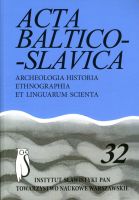Балтийское наследие в восточной Беларуси: новые исторические и лингвистические данные об Обольцах
Baltic heritage in Western Belarus: new historic and linguistic data about Oboltzy
Author(s): Vykintas Vajtkiavičius, Julia GurskayaSubject(s): Language and Literature Studies
Published by: Instytut Slawistyki Polskiej Akademii Nauk
Keywords: areology; archaeological monuments; dynamics of the historical anthroponyms; onomastics; ethnolinguistic contacts.
Summary/Abstract: Historian E. Ochmanski was the first to introduce the statement about Baltic heritage in Oboltzy region (Tolochinski and Sennenski rayons of Vitebsk region (Oblast). He considered that the Oboltzy Baltic heritage is autochthonous by nature. A.P. Nepokupny considered that the Lithuanian occupation of Oboltzi is the most trustworthy as well as the occupation of other West Slavonic lands. The article presents and investigates the data of the complex investigations in 2006 the main aim of which is to prove the E. Ochmanski hypothesis as well as to find new data in the above mentioned region. Combination of field investigations together with the historic and linguistic archive files permitted us to find some new aspects of the Baltic-Slavonic relations on the territory of Western Belarus. Аncient settlement situated on the left tributary of the river Obolianka near Kleban village(its historic name is Old Oboltzy) is became one of the most significant discoveries (pic 1). By its appearance and analogies in Vitebsk Podvinie and Orsha Podniprovie the settlement can be attributed to the third quarter of the 1st millennium AD. The question of its earlier and late existence is still opened. 0,3 km. to the West of the settlement on the bank of the same Obolianka tributary there is a place where the Catholic Oboletzky church was situated till the middle of the XX century (pic 2,3). Due to archaeological data the cultural layer contains ceramics of the XIV–XVI centuries and overgrowth. This allows us to consider though with some hesitation that the Oboletzky court of the Greate Lithuanian King Jagailo was situated here. Taking into consideration the fact that the Greate King Yagailo was the founder of the Oboltzy Cherch in 1387 the remains of the first Cathilic church can also be found here. Taking into consideration the above mentioned it can be considered that in XIV–XVI centucies Oboltzy administrative, political and cultural center in the upper river Obolianka stream was founded by the Kings of the Greate Principality of Lithuania not on a spear (not occupied) place but on the place of the previously reinforced settlement that was the center of the tribal or perhaps even early state era. While investigating interconfessional relations in Oboltzy it was discovered that interrelations between anthroponomy of the Baltic origin and the Catholic religion (that is typical for central part of Belarus) does not fully correspond in case of Oboltzy. This fact made it significantly difficult to find the Baltic heritage in Oboltzy. That is why we analyzed the linguistic, chronological and geographic analyses of the anthroponomy.
Journal: Acta Baltico Slavica
- Issue Year: 2008
- Issue No: 32
- Page Range: 9-30
- Page Count: 22
- Language: Russian

